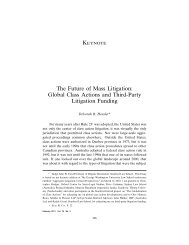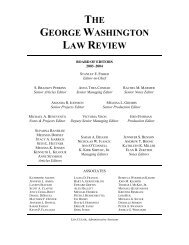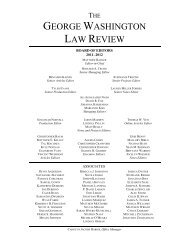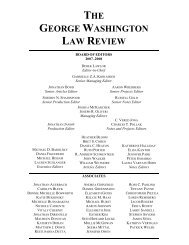View PDF - The George Washington Law Review
View PDF - The George Washington Law Review
View PDF - The George Washington Law Review
Create successful ePaper yourself
Turn your PDF publications into a flip-book with our unique Google optimized e-Paper software.
2010] Oral History and the Study of the Judiciary 849<br />
This presents something of a problem for those who want to understand<br />
judicial behavior. Judges themselves possess unique insights<br />
into the nature and character of the role, but there is reason to suspect<br />
that those judges who go out of their way to address the topic are not<br />
representative of their peers. Recent academic work has made some<br />
headway in accounting for the conduct of the judiciary as a whole.<br />
Political scientists, in particular, have focused their efforts on quantitative<br />
empirical study of judicial behavior, 17 and in recent years they<br />
have been joined by an increasing number of scholars within law<br />
schools. 18 This work is characterized by its focus on what judges have<br />
actually done (i.e., how they have voted in cases) versus what they say<br />
they are doing in their opinions. At roughly the same time, other<br />
scholars have brought the insights of other social sciences—primarily<br />
economics and psychology—to the quest to understand judicial<br />
behavior. 19<br />
All of this work has been valuable, much of it incredibly so. But<br />
there remains a sense in which the resulting picture is incomplete.<br />
Quantitative studies provide a picture of the judiciary as a whole, but<br />
speak only in generalities. Qualitative accounts are useful to round<br />
things out, but the self-selected nature of judicial writings on the judicial<br />
process suggests that such accounts provide an incomplete perspective<br />
as well. Judges who have chosen to write about the processes<br />
of judging may have different perspectives than those who have not,<br />
and it is consequently difficult to conclude that their insights apply<br />
broadly to other judges.<br />
A book like William Domnarski’s Federal Judges Revealed 20 holds<br />
out the promise of filling this gap. <strong>The</strong> book is constructed around<br />
oral histories of roughly 100 federal judges at both the district- and<br />
circuit-court levels. Its raw material, in other words, consists of dis-<br />
17 E.g., JEFFREY A. SEGAL & HAROLD J. SPAETH, THE SUPREME COURT AND THE ATTI-<br />
TUDINAL MODEL REVISITED (2002); JEFFREY A. SEGAL ET AL., THE SUPREME COURT IN THE<br />
AMERICAN LEGAL SYSTEM (2005).<br />
18 E.g., LEE EPSTEIN & JACK KNIGHT, THE CHOICES JUSTICES MAKE 9–10 (1997); SUN-<br />
STEIN ET AL., supra note 7, at 3; Jason J. Czarnezki & William K. Ford, <strong>The</strong> Phantom Philosophy?<br />
An Empirical Investigation of Legal Interpretation, 65 MD. L. REV. 841 (2006); <strong>The</strong>odore<br />
W. Ruger et al., <strong>The</strong> Supreme Court Forecasting Project: Legal and Political Science Approaches<br />
to Predicting Supreme Court Decisionmaking, 104 COLUM. L. REV. 1150, 1151–52 (2004); Gregory<br />
Sisk, Judges Are Human, Too, 83 JUDICATURE 178, 178 (2000).<br />
19 E.g., Chris Guthrie et al., Blinking on the Bench: How Judges Decide Cases, 93 CORNELL<br />
L. REV. 1, 3 (2007); Chris Guthrie et al., Inside the Judicial Mind, 86 CORNELL L. REV. 777, 784<br />
(2001); Andrew J. Wistrich et al., Can Judges Ignore Inadmissible Information? <strong>The</strong> Difficulty of<br />
Deliberately Disregarding, 153 U. PENN. L. REV. 1251, 1259 (2005).<br />
20 WILLIAM DOMNARSKI, FEDERAL JUDGES REVEALED (2009).



